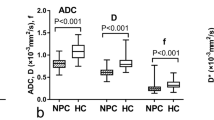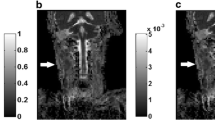Abstract
Purpose
To determine the correlation between intravoxel incoherent motion (IVIM) and dynamic contrast-enhanced (DCE) magnetic resonance imaging (MRI) parameters.
Methods
Thirty-eight newly diagnosed NPC patients were prospectively enrolled. Diffusion-weighted images (DWI) at 13 b-values were acquired using a 3.0-T MRI system. IVIM parameters including the pure molecular diffusion (D), perfusion-related diffusion (D*), perfusion fraction (f), DCE-MRI parameters including maximum slope of increase (MSI), enhancement amplitude (EA) and enhancement ratio (ER) were calculated by two investigators independently. Intra- and interobserver agreement were evaluated using the intraclass correlation coefficient (ICC) and Bland-Altman analysis. Relationships between IVIM and DCE-MRI parameters were evaluated by calculation of Spearman’s correlation coefficient.
Results
Intra- and interobserver reproducibility were excellent to relatively good (ICC = 0.887-0.997; narrow width of 95 % limits of agreement). The highest correlation was observed between f and EA (r = 0.633, P < 0.001), with a strong correlation between f and MSI (r = 0.598, P = 0.001). No correlation was observed between f and ER (r = -0.162; P = 0.421) or D* and DCE parameters (r = 0.125–0.307; P > 0.119).
Conclusion
This study suggests IVIM perfusion imaging using 3.0-T MRI is feasible in NPC, and f correlates significantly with EA and MSI.
Key Points
• Assessment of tumour perfusion is important in nasopharyngeal carcinoma.
• DCE-MRI provided perfusion information with the use of intravenous contrast media.
• Perfusion information could be provided by non-invasive IVIM MRI.
• IVIM parameter f correlated with DCE-MRI parameters.





Similar content being viewed by others
Abbreviations
- CBV:
-
Cerebral blood volume
- D:
-
Pure molecular diffusion
- DCE:
-
Dynamic contrast-enhanced
- DWI:
-
Diffusion-weighted images
- D*:
-
Perfusion-related diffusion
- EA:
-
Enhancement amplitude
- ER:
-
Enhancement ratio
- f:
-
Perfusion fraction
- FOV:
-
Field of view
- IVIM:
-
Intravoxel incoherent motion
- ICC:
-
Intraclass correlation coefficient
- LoA:
-
Limits of agreement
- MRI:
-
Magnetic resonance imaging
- MSI:
-
Maximum slope of increase
- MVD:
-
Microvessel density
- MTT:
-
Mean transit time
- NEX:
-
Number of excitations
- NPC:
-
Nasopharyngeal carcinoma
- SPGR:
-
Spoiled gradient-recalled echo
- TR:
-
Repetition time
- TE:
-
Echo time
- TICs:
-
Time-signal intensity curves
- VEGFR-2:
-
Vascular endothelial growth factor receptor 2
References
Parkin DM, Bray F, Ferlay J, Pisani P (2005) Global cancer statistics, 2002. CA Cancer J Clin 55:74–108
Fu Y-S, Wenig BM, Abemayor E, Wenig B (2001) Head and neck pathology with clinical correlations. Philadelphia (Pa) 7:602
Jin G, Su D, Liu L, Zhu X, Xie D, Zhao W (2011) The accuracy of computed tomographic perfusion in detecting recurrent nasopharyngeal carcinoma after radiation therapy. J Comput Assist Tomogr 35:26–30
Huang B, Wong CS, Whitcher B et al (2013) Dynamic contrast-enhanced magnetic resonance imaging for characterising nasopharyngeal carcinoma: comparison of semiquantitative and quantitative parameters and correlation with tumour stage. Eur Radiol 23:1495–1502
Semiz Oysu A, Ayanoglu E, Kodalli N, Oysu C, Uneri C, Erzen C (2005) Dynamic contrast-enhanced MRI in the differentiation of posttreatment fibrosis from recurrent carcinoma of the head and neck. Clin Imaging 29:307–312
Lee FK, King AD, Ma BB, Yeung DK (2012) Dynamic contrast enhancement magnetic resonance imaging (DCE-MRI) for differential diagnosis in head and neck cancers. Eur J Radiol 81:784–788
Liu C, Liang C, Liu Z, Zhang S, Huang B (2013) Intravoxel incoherent motion (IVIM) in evaluation of breast lesions: comparison with conventional DWI. Eur J Radiol 82:e782–e789
Le Bihan D, Breton E, Lallemand D, Aubin ML, Vignaud J, Laval-Jeantet M (1988) Separation of diffusion and perfusion in intravoxel incoherent motion MR imaging. Radiology 168:497–505
Le Bihan D, Turner R, MacFall JR (1989) Effects of intravoxel incoherent motions (IVIM) in steady-state free precession (SSFP) imaging: application to molecular diffusion imaging. Magn Reson Med 10:324–337
Le Bihan D, Turner R (1992) The capillary network: a link between IVIM and classical perfusion. Magn Reson Med 27:171–178
Federau C, O’Brien K, Meuli R, Hagmann P, Maeder P (2013) Measuring brain perfusion with intravoxel incoherent motion (IVIM): initial clinical experience. J Magn Reson Imaging. doi:10.1002/jmri.24195
Sumi M, Van Cauteren M, Sumi T, Obara M, Ichikawa Y, Nakamura T (2012) Salivary gland tumors: use of intravoxel incoherent motion MR imaging for assessment of diffusion and perfusion for the differentiation of benign from malignant tumors. Radiology 263:770–777
Sumi M, Nakamura T (2013) Head and neck tumours: combined MRI assessment based on IVIM and TIC analyses for the differentiation of tumors of different histological types. Eur Radiol. doi:10.1007/s00330-013-3002-z
Lai V, Li X, Lee VH, Lam KO, Chan Q, Khong PL (2013) Intravoxel incoherent motion MR imaging: comparison of diffusion and perfusion characteristics between nasopharyngeal carcinoma and post-chemoradiation fibrosis. Eur Radiol. doi:10.1007/s00330-013-2889-8
Lai V, Li X, Lee VH et al (2013) Nasopharyngeal carcinoma: comparison of diffusion and perfusion characteristics between different tumour stages using intravoxel incoherent motion MR imaging. Eur Radiol. doi:10.1007/s00330-013-2995-7
Luciani A, Vignaud A, Cavet M et al (2008) Liver cirrhosis: intravoxel incoherent motion MR imaging–pilot study. Radiology 249:891–899
Pang Y, Turkbey B, Bernardo M et al (2013) Intravoxel incoherent motion MR imaging for prostate cancer: an evaluation of perfusion fraction and diffusion coefficient derived from different b-value combinations. Magn Reson Med 69:553–562
Bland JM, Altman DG (1986) Statistical methods for assessing agreement between two methods of clinical measurement. Lancet 1:307–310
Zhang JL, Sigmund EE, Chandarana H et al (2010) Variability of renal apparent diffusion coefficients: limitations of the monoexponential model for diffusion quantification. Radiology 254:783–792
Koh DM, Collins DJ, Orton MR (2011) Intravoxel incoherent motion in body diffusion-weighted MRI: reality and challenges. AJR Am J Roentgenol 196:1351–1361
Lewin M, Fartoux L, Vignaud A, Arrive L, Menu Y, Rosmorduc O (2011) The diffusion-weighted imaging perfusion fraction f is a potential marker of sorafenib treatment in advanced hepatocellular carcinoma: a pilot study. Eur Radiol 21:281–290
Lee HJ, Rha SY, Chung YE et al (2013) Tumor perfusion-related parameter of diffusion-weighted magnetic resonance imaging: correlation with histological microvessel density. Magn Reson Med. doi:10.1002/mrm.24810
Thomassin-Naggara I, Bazot M, Darai E, Callard P, Thomassin J, Cuenod CA (2008) Epithelial ovarian tumors: value of dynamic contrast-enhanced MR imaging and correlation with tumor angiogenesis. Radiology 248:148–159
Patel J, Sigmund EE, Rusinek H, Oei M, Babb JS, Taouli B (2010) Diagnosis of cirrhosis with intravoxel incoherent motion diffusion MRI and dynamic contrast-enhanced MRI alone and in combination: preliminary experience. J Magn Reson Imaging 31:589–600
Guiu B, Petit JM, Capitan V et al (2012) Intravoxel incoherent motion diffusion-weighted imaging in nonalcoholic fatty liver disease: a 3.0-T MR study. Radiology 265:96–103
Miyazaki K, Collins DJ, Walker-Samuel S et al (2008) Quantitative mapping of hepatic perfusion index using MR imaging: a potential reproducible tool for assessing tumour response to treatment with the antiangiogenic compound BIBF 1120, a potent triple angiokinase inhibitor. Eur Radiol 18:1414–1421
Pierpaoli C, Basser PJ (1996) Toward a quantitative assessment of diffusion anisotropy. Magn Reson Med 36:893–906
Jones DK (2004) The effect of gradient sampling schemes on measures derived from diffusion tensor MRI: a Monte Carlo study. Magn Reson Med 51:807–815
Henkelman RM (1990) Does IVIM measure classical perfusion? Magn Reson Med 16:470–475
Wirestam R, Borg M, Brockstedt S, Lindgren A, Holtas S, Stahlberg F (2001) Perfusion-related parameters in intravoxel incoherent motion MR imaging compared with CBV and CBF measured by dynamic susceptibility-contrast MR technique. Acta Radiol 42:123–128
Edelman RR, Mattle HP, Atkinson DJ et al (1990) Cerebral blood flow: assessment with dynamic contrast-enhanced T2*-weighted MR imaging at 1.5 T. Radiology 176:211–220
King AD, Ahuja AT, Yeung DK et al (2007) Malignant cervical lymphadenopathy: diagnostic accuracy of diffusion-weighted MR imaging. Radiology 245:806–813
Acknowledgments
This work was supported by grants from the National Natural Science Foundation of China (nos. 81271654, 81271569 and 81171329) and Science and Technology Support Program of Guangzhou, China (2010J-E481). We gratefully acknowledge the assistance of Zhong-Ping Zhang (MD, from Applied Science Lab, GE Healthcare, Guangzhou, Guangdong Prov., P. R. China) for support with IVIM methodology and for linguistic editing.
The scientific guarantor of this publication is Chang-Hong Liang. The authors of this manuscript declare relationships with the following companies: GE Healthcare. No complex statistical methods were necessary for this paper. Institutional Review Board approval was obtained. Written informed consent was obtained from all subjects (patients) in this study. Methodology: Prospective, diagnostic or prognostic study, performed at one institution.
Author information
Authors and Affiliations
Corresponding author
Additional information
Qian-Jun Jia and Shui-Xing Zhang contributed equally to this manuscript.
Rights and permissions
About this article
Cite this article
Jia, QJ., Zhang, SX., Chen, WB. et al. Initial experience of correlating parameters of intravoxel incoherent motion and dynamic contrast-enhanced magnetic resonance imaging at 3.0 T in nasopharyngeal carcinoma. Eur Radiol 24, 3076–3087 (2014). https://doi.org/10.1007/s00330-014-3343-2
Received:
Revised:
Accepted:
Published:
Issue Date:
DOI: https://doi.org/10.1007/s00330-014-3343-2




